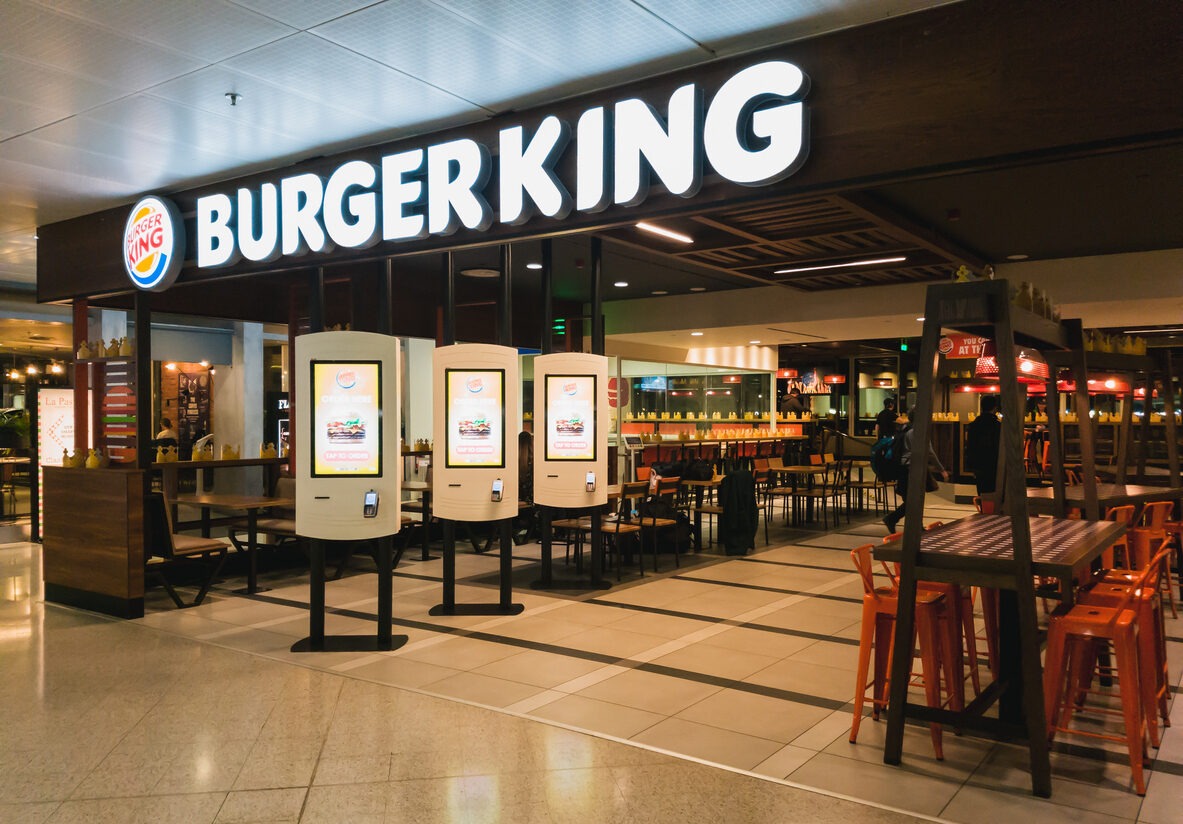
iStock.com/IB_photo
Should Fast-Food Chains Fully Commit to Digital Kiosks?
In the fast-food world, big names like Burger King, Shake Shack, and KFC are on a mission to roll out digital order kiosks across the U.S. These kiosks are popping up left and right, promising a smoother ordering experience and potentially heftier checks for customers. Unsurprisingly, the COVID-19 pandemic acted as a catalyst for the acceptance of digital ordering. With more people accustomed to online transactions, the transition to kiosks has been smooth so far.
According to Business Insider, “Patrick Doyle, executive chairman of RBI, which owns Burger King, Popeyes, Tim Hortons, and Firehouse Subs, told investors in November that kiosks were ‘a win on every single front.’”
It’s no secret why fast-food chains are embracing this digital transformation. These kiosks are not only streamlining operations but also proving to be lucrative investments. Let’s break down why:
- Labor savings: By automating the ordering process, restaurants can trim down on labor costs. This means they can either hire fewer staff members or redirect them to other crucial areas like the kitchen or the drive-thru. As Sharon Zackfia, an industry analyst, puts it, “You are basically able to arbitrage the labor into more value-added activities.”
- Increased accuracy: For those who have received the wrong order at a fast-food joint, digital kiosks aim to put an end to that. They ensure orders are precise, eliminating the frustration of mix-ups and returns.
- Boosted sales: Studies show that customers tend to spend more when using kiosks. Whether it’s upselling to larger portions, adding sides, or indulging in customizations, these kiosks are masters at nudging customers to splurge a little extra. As a matter of fact, “Shake Shack CEO Randy Garutti told investors in February that people who ordered at kiosks rather than at cashiers spent on average nearly 10% more.”
- Multipurpose use: When kiosks are not being used, they can be used to display special deals and promotions or for general advertising.
Who’s in the Fast-Food Digital Kiosk Game?
The big players in the fast-food industry are all jumping on the bandwagon:
- Burger King: According to parent company Restaurant Brands International’s CEO Josh Kobza, current plans are to digitize 100% of its business. This comes after Burger King witnessed “tremendous results” from its pilot programs, in the CEO’s words.
- Shake Shack: Nearly all of Shake Shack’s U.S. restaurants now boast these sleek kiosks, with kiosk sales doubling year-over-year in the fourth quarter. CFO Katie Fogertey told investors last November that kiosks make up “well over” half of the chain’s in-person orders.
- Taco Bell and KFC: Under Yum Brands, these iconic chains are also embracing kiosk technology, aiming to enhance customer experience and drive profits. All of Taco Bell’s U.S. restaurants have kiosks for customers, and KFC had them in around 500 U.S. locations by the end of 2023, “a huge step up from nearly zero only two quarters before,” according to Yum Brand’s CFO Chris Turner.
Habit Burger Grill is another chain owned by Yum Brands that is aggressively adopting kiosks, with Yum Brands CEO David Gibbs citing higher sales and improved profit margins as key incentives. “Average kiosk sales see 10% higher checks than front counter sales and excellent profit flow-through,” he told investors. Currently, 60% of Habit locations have kiosks.
The digital kiosk trend can be traced back to pioneers like Panera Bread and McDonald’s, which paved the way for widespread kiosk adoption nearly a decade ago.
While initial hesitance from other chains stemmed from concerns over cost and customer acceptance, international markets embraced kiosk technology early on. Now, the pandemic-induced labor challenges and the subsequent inflationary environment have propelled kiosks into the spotlight as a viable solution.
The advantages are clear: Kiosks can boost sales by encouraging larger orders and offer potential labor savings by automating the ordering process. El Pollo Loco CEO Larry Roberts highlighted the significant customer uptake when kiosks are introduced, particularly when they accept cash or electronic benefit transfer (EBT).
Moreover, digital orders through kiosks provide valuable customer data, enabling personalized marketing and upselling opportunities.
Downsides to Kiosks at Fast-Food Restaurants
But let’s not overlook the potential downsides. Some argue that the human touch is irreplaceable, and there are concerns about job displacement. Moreover, while kiosks may increase sales, they also raise questions about consumer privacy and data security.
Additionally, digital kiosks may also come with potential costs for consumers. Here’s how they might be impacting consumers’ wallets:
- Initial investment: Restaurants invest heavily in hardware, software, and staff training for kiosks, and consumers often end up covering these costs.
- Operational expenses: Ongoing maintenance and servicing of kiosks lead to additional expenses, which could translate to slightly higher menu prices.
- Upselling: Kiosks excel at encouraging customers to add extras to their orders, driving up the total bill at checkout.
- Pricing flexibility: Restaurants can adjust menu items and prices on the fly with kiosks, potentially leading to fluctuating prices for consumers.
- Consumer behavior: With more people using digital ordering, there’s a trend toward convenience and customization, which may result in higher-priced menu options to cater to evolving tastes.
Something else to note is that digital kiosks might make it more difficult to order secret menu items from fast-food retailers.
Discussion Questions
How can fast-food chains take advantage of the efficiency gains of digital kiosks while still preserving personalized customer interactions and addressing dietary preferences?
What steps should fast-food restaurants take to protect consumer privacy with digital kiosks, and how can they ensure these measures work well?
Considering the potential impact on consumer wallets, including rising menu prices and potential menu item displacement, what strategies should fast-food chains employ to ensure fair pricing and accessibility while leveraging the benefits of digital kiosk technology?
